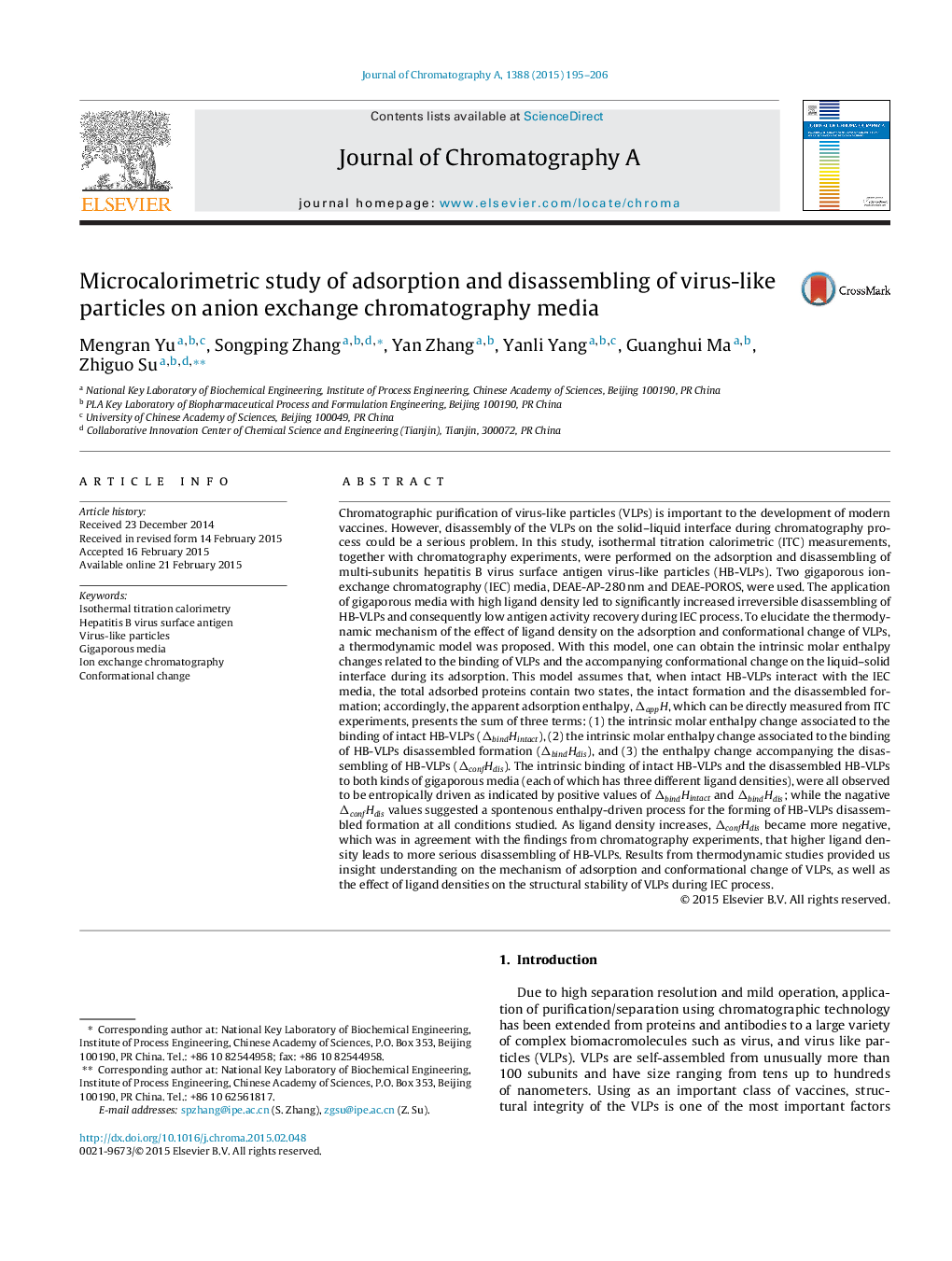| کد مقاله | کد نشریه | سال انتشار | مقاله انگلیسی | نسخه تمام متن |
|---|---|---|---|---|
| 1201906 | 1493538 | 2015 | 12 صفحه PDF | دانلود رایگان |
• ITC study was performed on adsorption and disassembling of HB-VLPs during anion exchange chromatography.
• Media with higher ligand density lead more serious disassembling of HB-VLPs.
• Thermodynamic model was developed to obtain enthalpies related to adsorption and disassembling of VLPs.
• Disassembling of VLPs is spontenous enthalpy-driven process.
• As ligand density increase, enthalpy change related to VLPs disassembling become more negative.
Chromatographic purification of virus-like particles (VLPs) is important to the development of modern vaccines. However, disassembly of the VLPs on the solid–liquid interface during chromatography process could be a serious problem. In this study, isothermal titration calorimetric (ITC) measurements, together with chromatography experiments, were performed on the adsorption and disassembling of multi-subunits hepatitis B virus surface antigen virus-like particles (HB-VLPs). Two gigaporous ion-exchange chromatography (IEC) media, DEAE-AP-280 nm and DEAE-POROS, were used. The application of gigaporous media with high ligand density led to significantly increased irreversible disassembling of HB-VLPs and consequently low antigen activity recovery during IEC process. To elucidate the thermodynamic mechanism of the effect of ligand density on the adsorption and conformational change of VLPs, a thermodynamic model was proposed. With this model, one can obtain the intrinsic molar enthalpy changes related to the binding of VLPs and the accompanying conformational change on the liquid–solid interface during its adsorption. This model assumes that, when intact HB-VLPs interact with the IEC media, the total adsorbed proteins contain two states, the intact formation and the disassembled formation; accordingly, the apparent adsorption enthalpy, ΔappH, which can be directly measured from ITC experiments, presents the sum of three terms: (1) the intrinsic molar enthalpy change associated to the binding of intact HB-VLPs (ΔbindHintact), (2) the intrinsic molar enthalpy change associated to the binding of HB-VLPs disassembled formation (ΔbindHdis), and (3) the enthalpy change accompanying the disassembling of HB-VLPs (ΔconfHdis). The intrinsic binding of intact HB-VLPs and the disassembled HB-VLPs to both kinds of gigaporous media (each of which has three different ligand densities), were all observed to be entropically driven as indicated by positive values of ΔbindHintact and ΔbindHdis; while the nagative ΔconfHdis values suggested a spontenous enthalpy-driven process for the forming of HB-VLPs disassembled formation at all conditions studied. As ligand density increases, ΔconfHdis became more negative, which was in agreement with the findings from chromatography experiments, that higher ligand density leads to more serious disassembling of HB-VLPs. Results from thermodynamic studies provided us insight understanding on the mechanism of adsorption and conformational change of VLPs, as well as the effect of ligand densities on the structural stability of VLPs during IEC process.
Journal: Journal of Chromatography A - Volume 1388, 3 April 2015, Pages 195–206
